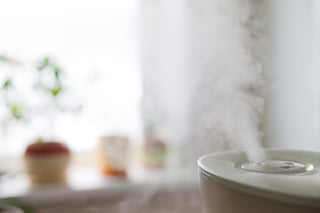
Let’s face it, managing humidity levels in your home can be a challenge. In winter, it seems like one day your throat is dry and scratchy, the next, your windows are icing over. In summer, you feel clammy one day, and the next, you’re scratching dry skin and reaching for the hand lotion. So, what is the proper level of home humidity for Minnesotans? And what can we do to keep our homes comfortable for our families and pets?
Here's everything you need to know about finding the ideal indoor humidity level.
Signs of Too Much or Too Little Humidity
Your five senses will clue you in to any humidity issues. A musty or moldy smell is a big indicator that an area of your home has too much moisture. Keith Hill, technical support manager at Minnesota Air, says that mold can grow at a 60% humidity level. That means you may see mold growth in places where you’re getting too much moisture.
When it comes to the other end of the spectrum – not enough moisture in your home – you’ll be able to see it, hear it, and feel it. You may see cracks in wood flooring or furnishings. You may hear your floors and doors creak a little more – especially in the drier winter months. And you may feel some of the more uncomfortable signs of low humidity – static electric shocks, dry skin, and chapped lips.
Unfortunately, some signs of humidity imbalance can be more than just uncomfortable. They can lead to health issues and damage to your home. With low humidity, chapped skin and lips can mean more colds and viruses or skin infections. For your home, it can mean warping doors, splitting furniture, or peeling paint. With high humidity and mold comes any number of concerns: allergies, asthma, and other respiratory problems, wood rot – and pests that eat away at it – and even structural damage to your home over the long term.
Causes and Effects of High or Low Humidity
For some families, moisture generated by normal day-to-day activities can lead to high humidity levels. Showers, cooking, laundry, and dishwashers naturally add moisture to the air. High humidity levels within your home can cause moisture to condense on windows, water to “sweat” on walls, and rust and mold to form. In winter, the outdoor air is so dry that it affects your indoor relative humidity when it enters your home. In summer, too low a temperature setting on your AC can also reduce humidity.
Low Humidity Issues
Problems with low humidity generally occur in the winter months, when the outside air is its driest. When that air enters your home, it lowers the indoor humidity level. In addition to dry, cracked skin, some signs of low humidity can include scratchy throats, itchy eyes, and chapped lips. If prolonged, those symptoms can lead to infections, colds, and viruses.
Your home can also show signs of low humidity. Beyond cracks in your floor and creaky floors, signs of low humidity can include gaps in molding, warped doors, split furniture, and peeling wallpaper, sealants, and glues. Just like skin, everything dries out and is open to further damage if not addressed.
High Humidity Issues
High humidity issues occur most often in summer, but can also happen in winter, especially if your home is very tightly sealed or if humidity is added by other means – steamy showers, vaporizers, and so on. If you notice condensation – or even ice buildup – on your windows, that’s an indication that indoor humidity is too high and the indoor window surface is too cold. Do your bathrooms or basements smell damp or musty? That means there isn’t enough airflow to whisk the moisture and humidity away, so it stays put in the floors and walls of your home, which can lead to mold.
How to Check Your Home's Humidity Level
Besides using your senses to determine if you have a humidity problem, there are instruments and tools to help you get a more accurate sense of what your humidity levels actually are.
Keith says one of the better instruments is a hygrometer – or humidity gauge. Many new digital thermostats have one built-in. “That makes it very convenient – we already look to the thermostat for temperature, so why not have both on the same device?” he says. “Many can be set up to display it on the main screen along with the temperature. Some require you to push a button to see it. Some that are internet-linked will even show the temperature and humidity on your smartphone or tablet.”
Keith notes that most of the thermostats that have built-in humidity sensors will also control a humidity appliance such as a humidifier or a dehumidifier. He recommends checking with a pro to see what options there are for your system because a whole-house humidifier/dehumidifier is one of the best solutions for remedying moisture issues. For other solutions, check out our blog on home humidity solutions.
If you need a separate device to read humidity, look for a quality digital device, Keith says. “Low priced humidity gauges are not accurate,” he says. “Spend a few extra dollars to get a precise instrument.”
Optimal Home Humidity Levels
The University of Minnesota has developed guidelines for the maximum recommended humidity levels for homes. Based on a 70ºF interior room temperature, and single-pane windows, engineering studies established the following guidelines. Above these values, your windows may “sweat” or frost. (Add 10 to 15% to the humidity values for double-pane or triple-pane windows.)
Outside Temperature |
Inside Humidity |
| 20º to 40º | Not over 40% |
| 10º to 20ºF | Not over 35% |
| 0º to 10ºF | Not over 30% |
| -10º to 0ºF | Not over 25% |
| -20º to –10ºF | Not over 20% |
| -20ºF or below | Not over 15% |
Managing Your Home’s Humidity
There are several options when it comes to balancing humidity and controlling moisture in your home. The EPA says that by “air-sealing and using energy-efficient construction, uncontrolled air leakage is greatly reduced, a more controlled indoor environment is created, and moisture can be maintained at acceptable levels without the use of a humidifier.”
So, no matter the weather – hot or cold – make sure your home is properly sealed. Fill in cracks around your foundation, put weather stripping around the windows, and seal the threshold of your doors and garage. Where air can escape, air can get in, and that means anything from outside (allergens, humidity, pollen) can enter your home.
By reducing uncontrolled outdoor air (infiltration) you will maintain a more stable humidity level in the winter months, and may not need a humidifier. If you do need to add more humidity, you may be able to get by with an inexpensive room humidifier. They add moisture just fine but they require filling daily and frequent cleaning. A whole-house humidifier refills itself, circulates the humidity throughout the house automatically, and has self-cleaning features to reduce the amount and frequency of maintenance.
In summer, the first line of defense is to keep humidity from entering your home in the first place. That means when it’s humid out, keep the windows closed and run your AC to decrease humidity. Only when it is cool and dry should you open those windows for comfort.
If your home is well-sealed and you have properly working AC, that should keep your humidity in check during warm weather But what about those days when you have high humidity and there is no need for AC? Think rainy or foggy 70ºF day. Your air conditioner can’t dehumidify if it doesn’t run, but who wants to run their AC when it's 70ºF outside? Besides, you would have to “overcool” your home to remove moisture, pushing up your energy costs!
Consider a dehumidifier, whether it’s a portable room model or a whole-house dehumidifier. Either will get the job done on those “cooler” summer days. The room unit requires daily maintenance (emptying, filter changes, cleaning, and so on) to avoid becoming a breeding ground for biological contaminants like mold. A whole-home dehumidifier system is a better, long-term solution. It offers more efficient, year-round control compared to standalone units. It’s installed as part of your HVAC system and is able to provide your entire home with balanced humidity.
Adjusting Your Home’s Humidity
If you have a whole-house humidifier/dehumidifier, it will be controlled by a humidistat, which works similarly to a thermostat. A ventilator (HRV or ERV) can also be used to control wintertime humidity and it can also be controlled by your humidistat. A good rule of thumb for controlling humidity in the winter: If frost or condensation forms on your windows, the humidity is too high and you should turn down the humidistat. If your hardwood floors start to separate, the humidity is too dry and you should turn up your humidistat. Remember, you may need to occasionally adjust it, depending on the outdoor temperature and your comfort level.
Sometimes, turning down your humidistat isn’t quite enough. You may have to resort to additional measures to reduce moisture in the air, such as running your bathroom exhaust fan during baths and showers, and for an additional 30 minutes or longer after bathing or showering to remove moisture from the room. Also, operate the kitchen exhaust fan when you’re cooking.
Adding humidity to a dry house is fairly straightforward. A whole-house humidifier is best but an inexpensive stand-alone, cool mist humidifier will get the job done. Clean humidifiers regularly, especially the stand-alone models, and don't let water stand in the bottom of them – humidifiers can put harmful microorganisms or bacteria into the air if not properly maintained.
Knowing and managing your home’s humidity levels will leave you feeling healthier and more comfortable while protecting your home at the same time. If you need help controlling your home’s humidity or want to learn more about a whole-home humidifier/dehumidifier system, use our convenient dealer locator to find a reliable HVAC pro near you.





